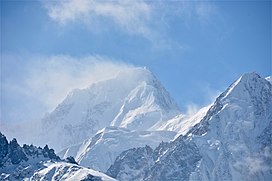Kunyang Chhish
| Kunyang Chhish | |||
|---|---|---|---|
| Simplified Chinese | 昆揚基什峰 | ||
| |||
Kunyang Chhish is the second-highest mountain in the Hispar Muztagh, a subrange in the Karakoram mountains in Pakistan. An alternate variations of the name are Kunyang Kish and Khinyang Chhish.[3] Its height, also sometimes given as 7,823 metres (25,666 ft), is ranked 21st in the world.
Location
Kunyang Chhish is located along the northern flank of the Hispar Glacier, one of the major glaciers of the Karakoram. It is the source of the Yazghil glacier that terminates in the heart of Shimshal Valley. It rises northeast of the confluence of the Hispar Glacier and the Kunyang Glacier, while Distaghil Sar (the highest peak of the Hispar Muztagh) dominates the Kunyang Glacier on its northern end.
Notable features
Kunyang Chhish is the 21st highest mountain in the world. It is also notable for its rise above local terrain: for example, it rises almost 4,000 metres (13,000 ft) above its southern base camp on the Kunyang Glacier, and it rises 5,500 metres (3.4 mi) above the Hunza valley in about 33 kilometres (108,000 ft). Though it shares a high key col with its parent Distaghil Sar to the north, it is a steep, pointed, and complex peak compared to Distaghil, which has a more rounded profile.
Not counting the two Pumari Chhish summits 4 kilometres (2.5 mi) to the ENE, the Kunyang Chhish massif has five peaks:
- Kunyang Chhish Main, 7,852 metres (25,761 ft)
- Kunyang Chhish South, 7,620 metres (25,000 ft), 700 m SSW, with a prominence of only about 100 metres (330 ft)
- Kunyang Chhish East 7,400 metres (24,300 ft), 2 km ESE, 240-metre (790 ft) prominence.
- Kunyang Chhish West, 7,350 metres (24,110 ft), 1.5 km W, 170-metre (560 ft) prominence. Also known as Pyramid Peak.
- Kunyang Chhish North, 7,108 metres (23,320 ft), 6 km NNE, 517-metre (1,696 ft) prominence.

Climbing history
The first attempt to climb Khunyang Chhish was made in 1962 but the climb was aborted after an avalanche on 18 July killed two climbers, Major James Mills and Captain M. R. F. Jones, at about 20,000 feet (6,100 m) on the south ridge.[4] Their bodies were never recovered.
The next attempt was in 1965 by a Japanese party mainly consisting of the University of Tokyo members. They also chose the south ridge of Kunyang Chhish, but another climber Takeo Nakamura died after the collapse of a narrow ridge at 7,200 m (23,600 ft).
The first ascent was accomplished by a Polish team led by Andrzej Zawada in 1971. They climbed a more direct, but nonetheless lengthy, route up the South Ridge of the peak from the Pumari Chhish Glacier. However, one of their members, Jan Franczuk, was killed in a crevasse accident.[3]
The second, and only other recorded ascent, was by two British climbers, Mark Lowe and Keith Milne, who climbed the Northwest Spur to the North Ridge and completed this route on July 11, 1988.[5] The route had first been attempted in 1980, and had been attempted again in 1981, 1982 and 1987.
The Himalayan Index lists three recent attempts on this peak, in 2000 and 2003. With just six known ascents and at least five confirmed deaths during attempts, the mountain has one of the steepest fatality rates in the Karakoram.
After four failed expeditions, starting in 2003, the East Summit was first ascended in July 2013 by an Austrian/Swiss team over the South Wall.[6] This ascent was nominated as one of the five finalists for the 2014 Piolet d'Or.[7]
See also
- List of mountains in Pakistan
- Gilgit-Baltistan, Pakistan
- Highest mountains of the World
- List of Ultras of the Karakoram and Hindu Kush
References
- ^ a b "Kunyang Chhish" on Peakbagger Retrieved 25 September 2011
- ^ Khunyang Chhish on bbs.keyhole.com
- ^ a b Kus, Andrzej (1971). "Khinyang Chhish climbed". Himalayan Journal. #31: 283–289. Retrieved 20 May 2024.
- ^ Braham, Trevor H. (1963). "Obituary - Major E. J. E. Mills, (1926-1962)". Himalayan Journal. #24: 139–140. Retrieved 11 June 2024.
- ^ Wingfield, Andy (1989). "Ups and Downs on Kunyang Kish - The Second Ascent, 11 July 1988" (PDF). Alpine Journal. #94 (338): 76–81. ISBN 978-0091737702. ISSN 0065-6569. Retrieved 11 June 2024.
- ^ "Hansjörg Auer » Kunyang Chhish East 2013" (in German). Retrieved 2024-12-09.
- ^ "PIOLETS D'OR 2014 Nominated ascents" (PDF). Archived from the original (PDF) on 24 September 2015.
- Jill Neate, High Asia: An Illustrated History of the 7000 Metre Peaks, ISBN 0-89886-238-8
- Orographical Sketch Map of the Karakoram by Jerzy Wala, 1990. Published by the Swiss Foundation for Alpine Research.
- Andy Fanshawe and Stephen Venables, Himalaya Alpine-Style, Hodder and Stoughton, 1995.
- American Alpine Journal
- Himalayan Index
- DEM files for the Himalaya (Corrected versions of SRTM data)
- "Khunyang Chhish". Peakware.com. Archived from the original on 2016-03-04.
- A list of world peaks ranked by local relief and steepness which includes Khunyang Chhish
External links
- Northern Pakistan - highly detailed placemarks of towns, villages, peaks, glaciers, rivers and minor tributaries in Google Earth Archived 2012-02-04 at the Wayback Machine
Kunyang Chhish North. A Japanese expedition from Hokkaido University in 1979 was led by Kohei Echizenya climbed the north ridge of Kunyang Chhish (23,321 feet) to make the first ascent. Base Camp was placed on the Kunyang Glacier at 14,300 feet on June 17. They followed the same route as the expedition to Pumari Chhish as far as the north col. Three camps, the highest Camp IV at 22,000 feet, were established on the north ridge. All eight climbers got to the summit on July 11.




